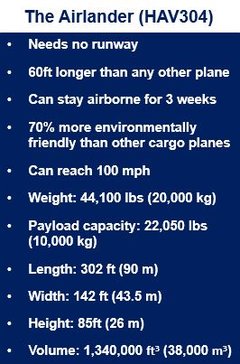A 302 foot aircraft, the Airlander (HAV304), part helicopter, airplane and airship has been unveiled in England, in what the developers call a potential game-changer in greener and more efficient air travel and freight transportation.
The makers of the aircraft, Hybrid Air Vehicles Ltd (HAV), believe that one day there will be as many of these hybrids as there are helicopters.
The HAV304, which can reach 100 mph (160 kph), is as long as Big Ben is high, and much longer than any passenger aircraft.
The Airlander can remain airborne for up to three weeks. Its makers say it will be delivering several tonnes of humanitarian aid across the globe, as well as carrying heavy freight.
Hybrid Air Vehicles Ltd. (HAV) says it plans to make luxury aircraft with 100-feet-long infinity pools, as well as safari planes and whale watching hybrids. As the hybrid plane can run on just one engine it emits much less noise and is ideal for observing timid wildlife.
Two variations of hybrid aircraft
Head of partnerships and communications at HAV, Chris Daniels, said:
“These do something nothing else does. There’s two variations – the ones that can stay in the air for a long period of time which can be used for things like communications and covering sports events.”
“They also have a pseudo-military use. Rather than having a police helicopter which are noisy and can only stay up for a limited period of time, these can stay airborne for a long time and be as overt or not as people want.”
The Airlander is a helicopter-airship-airplane hybrid.
The Airliner cost approximately £30 million ($50 million) to create. It is designed as a communications aircraft. However, HAV says it is about to begin making a larger ship this year with a 50-tonne-carrying capacity (freight and passengers). The company is expected to create about 1,000 jobs over the next couple of years.
HAV has just received a £2.5 million research grant from the UK government.
The bigger it is the (much) more it can carry

The hybrid’s carrying capacity is exponential in relation to its size. Helium is used to power the airships, meaning that for every doubling in length there is an eight-fold increase in load capacity.
Daniels believes the HAV will eventually be able to build aircraft capable of carrying 200 tonnes.
Rather than replacing current freight carried by trains in areas with good infrastructures, Daniels see the hybrids being extremely useful for transporting loads across hard-to-reach areas of the world, i.e. in Africa with its several security issues, and parts of Canada where the delivery of freight is becoming harder because of climate change.
The Airliner looks like a huge airship, but because of its unique aerodynamic shape it can create lift just like an airplane wing can. This allowed its creators to make it heavier than air so that the crew do not need to use ropes to hold it down.
Pressure control is achieved by a series of ballonets attached to the hulls.
It is powered by 4 x 350hp, four liter V8 direct injection, turbo-charge diesel engines. There are two engines mounted on the back of the hull and two in the front.
Some of its potential uses may be disturbing for many people. As well as being used to deliver huge quantities of humanitarian aid, it can also carry 7 to 8 tons of surveillance video, according to the promotional video below.
Stephen McGlennan, HAV’s CEO, said the company plans to build up to 1,000 hybrid planes. He added that governments and agencies worldwide have expressed interest in the aircraft.


